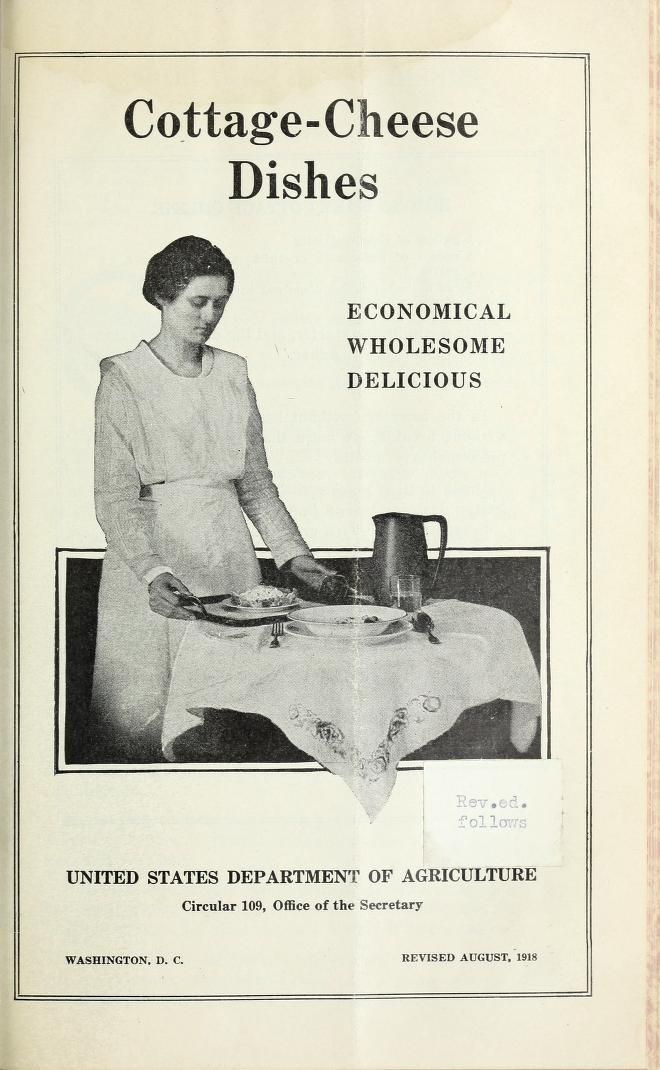|
I am an unabashed fan of cottage cheese. I don't know when I first realized how delicious it is. Growing up, it always seemed some rubbery gross thing old ladies on a diet ate. Probably because the cottage cheese I tasted was likely skimmed milk cottage cheese and probably not very good quality. I certainly didn't think serving it with fruit or jam was a good idea, as was often touted by advertisements.
These days, cottage cheese has largely been superseded by yogurt, as NPR discussed in 2015, but I'm not sure that's a good thing. Cottage cheese is a very old style of fresh cheeses - a family that also encompasses ricotta, mascarpone, cream cheese, feta, mozzarella, goat and other un-aged cheeses that spoil rather quickly compared to their older cousins. But while all those other cheeses get their praises sung, cottage cheese gets short shrift (although not as short as farmer cheese, pot cheese, and dry cottage cheese, which are even harder to find). This propaganda poster from World War I exhorts Americans to "Eat More Cottage Cheese" and "You'll Need Less Meat" - comparing the protein in a pound of cottage cheese favorably to a pound of beef, lamb, pork, veal, and chicken. The First World War saw a dairy surplus, especially in 1918 as dairy farmers across the country fought for better fluid milk prices as cheese and evaporated/condensed milk stores overflowed and feed and labor prices went up. Food preservationists encouraged people to eat more dairy products, especially in the spring of 1918 when a huge milk surplus going into spring dairy season boded ill for the farmers and fair prices. Cottage cheese was touted as a meat substitute to kill two birds with one stone - it ate up some of the dairy surplus while also allowing people to eat less meat. As the poster suggests, cottage cheese was also far cheaper than meat, and still is today, although the gap has closed somewhat. The current national average price for a pound of ground beef is $5.41, and in April, 2022 the average price of a pound of boneless chicken breast was over $4, the highest in 15 years. A pound of cottage cheese has held pretty much steady between $2 and $4/pound, depending on the brand. My local grocery store brand, which is quite good, has 24 oz. (1.5 pound) containers available for just over $3, and often $2.50 or less on sale. Cottage cheese was also touted as a substitute during World War II, and post-war skimmed milk cottage cheese was promoted as a high-protein diet food, which is perhaps why so many of the latter generations disdained it.
A number of cookbooks and recipe pamphlets promoting cottage cheese use were published during World War I, including the above 100 Money-Saving Cottage Cheese Recipes published in 1918 by the Gridley Dairy Company and containing recipes like "Liberty Loaf," "Cottage Cheese Relish," "Cheese Pancakes," and over a dozen recipes for "Cottage Cheese Pie," plus cheesecakes!
Much of the advertisement of cottage cheese tended toward the sweet, like this hilariously 1950s advertisement from Borden, which features cottage cheese with jam, with maple syrup, and with fruit in a salad:
But most of my favorite recipes for cottage cheese treat it like the savory cheese it is. It's great in dips for raw veggies, as a topping for roasted vegetables, in savory salads, and yes, as a substitute for meat in fried foods. I even use farmer cheese (drained cottage cheese) in my favorite pastry crust recipe, which I use to make everything from cookies and apple butter bars to Cornish pasties and lentils Wellington.
Frankly, most Progressive Era reformers would have been better off asking Eastern European immigrants for the best ways to use cottage cheese, as it features prominently in Russian, Polish, Ukrainian, and Georgian cuisines. The USDA did a little better with their accompanying pamphlet on cottage cheese cookery:
Cottage Cheese Dishes: Wholesome, Economical, Delicious was published in 1918 by the USDA and contains slightly more sensible, savory uses for cottage cheese, including in salad dressings, scrambled eggs with cottage cheese, potato croquettes, and a lovely-sounding cold weather dish they call "Cottage Cheese Roll," which is cottage cheese mixed with cooked rice or breadcrumbs, seasoned well, and mixed with chopped vegetables, olives or pickles, leftover cold meats, canned salmon, etc. and formed into a roll which is then sliced and served on a bed of shredded lettuce. A suggested "Hot Weather Supper" is "cottage cheese roll made with rice and leftover salmon, served on a bed of lettuce leaves, with mayonnaise dressing; sliced tomatoes, oatmeal bread with nuts, whey lemonade, crisp fifty-fifty raisin cookies." The menu hits all the World War I food spots with a meat substitute (no, salmon wasn't considered "meat"), using up leftovers, using cottage cheese, using wheatless bread with protein-giving nuts, waste-less whey lemonade, and inexpensive and likely low- or no-sugar raisin cookies for dessert. How's that for conforming to rationing directives!
It also includes directions for making cottage cheese (which is incredibly easy to do at home - you just need a lot of milk, heat, and patience) and more importantly in my mind, some recipes for using up the leftover whey, including the aforementioned whey lemonade! How do you like to eat your cottage cheese?
The Food Historian blog is supported by patrons on Patreon! Patrons help keep blog posts like this one free and available to the public. Join us for awesome members-only content like free digitized cookbooks from my personal collection, e-newsletter, and even snail mail from time to time! Don't like Patreon? Leave a tip!
0 Comments
|
AuthorSarah Wassberg Johnson has an MA in Public History from the University at Albany and studies early 20th century food history. Archives
July 2024
Categories
All
|




 RSS Feed
RSS Feed